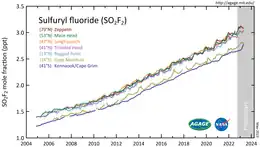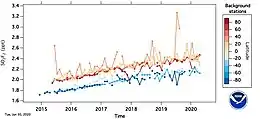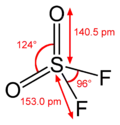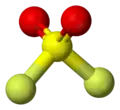Sulfuryl fluoride
Sulfuryl fluoride (also spelled sulphuryl fluoride) is an inorganic compound with the formula SO2F2. It is an easily condensed gas and has properties more similar to sulfur hexafluoride than sulfuryl chloride, being resistant to hydrolysis even up to 150 °C.[3] It is neurotoxic and a potent greenhouse gas, but is widely used as a fumigant insecticide to control termites.
| |||
| Names | |||
|---|---|---|---|
| IUPAC name
Sulfuryl fluoride | |||
| Other names
Sulfonyl fluoride; Sulfur dioxide difluoride; Sulphuryl fluoride; Sulfuryl difluoride; Vikane; Zythor | |||
| Identifiers | |||
3D model (JSmol) |
|||
| ChEBI | |||
| ChemSpider | |||
| ECHA InfoCard | 100.018.437 | ||
PubChem CID |
|||
| UNII | |||
CompTox Dashboard (EPA) |
|||
| |||
| |||
| Properties | |||
| SO2F2 | |||
| Molar mass | 102.06 g/mol | ||
| Appearance | colourless gas | ||
| Odor | odorless[1] | ||
| Density | 4.172 g/L (gas), 1.632 g/mL (liquid under compressed gas at 0 °C) | ||
| Melting point | −124.7 °C (−192.5 °F; 148.5 K) | ||
| Boiling point | −55.4 °C (−67.7 °F; 217.8 K) | ||
| 0.2% (0°C)[1] | |||
| Solubility in other solvents | SO2 | ||
| Vapor pressure | 15.8 atm (21°C)[1] | ||
| Structure | |||
| tetrahedral | |||
| Hazards | |||
| Occupational safety and health (OHS/OSH): | |||
Main hazards |
neurotoxin | ||
| NFPA 704 (fire diamond) | |||
| Lethal dose or concentration (LD, LC): | |||
LC50 (median concentration) |
991 ppm (rat, 4 hr)[2] | ||
LCLo (lowest published) |
1200 ppm (mouse, 1 hr) 5000 ppm (rabbit, 1 hr)[2] | ||
| NIOSH (US health exposure limits): | |||
PEL (Permissible) |
TWA 5 ppm (20 mg/m3)[1] | ||
REL (Recommended) |
TWA 5 ppm (20 mg/m3) ST 10 ppm (40 mg/m3)[1] | ||
IDLH (Immediate danger) |
200 ppm[1] | ||
| Related compounds | |||
Other anions |
SO2Cl2, SO2ClF | ||
Other cations |
SeO2F2 | ||
Related compounds |
SF6, SO3 SO2F3− | ||
Except where otherwise noted, data are given for materials in their standard state (at 25 °C [77 °F], 100 kPa).
Infobox references | |||
Structure, preparation, reactions
The molecule is tetrahedral with C2v symmetry. The S-O distance is 140.5 pm, S-F is 153.0 pm. As predicted by VSEPR, the O-S-O angle is more open than the F-S-F angle, 124° and 97°, respectively.[3]
One synthesis begins with the preparation of potassium fluorosulfite:[4]
- SO2 + KF → KSO2F
This salt is then chlorinated to give sulfuryl chloride fluoride:
- KSO2F + Cl2 → SO2ClF + KCl
Further heating at 180 °C of potassium fluorosulfite with the sulfuryl chloride fluoride gives the desired product:[5]
- SO2ClF + KSO2F → SO2F2 + KCl + SO2
Heating metal fluorosulfonate salts also gives this molecule:[3]
- Ba(OSO2F)2 → BaSO4 + SO2F2
It can be prepared by direct reaction of fluorine with sulfur dioxide:
- SO2 + F2 → SO2F2
On a laboratory scale, sulfuryl fluoride has been conveniently prepared from 1,1'-sulfonyldiimidazole, in the presence of potassium fluoride and acid.[6][7]
Sulfuryl fluoride is unreactive toward molten sodium metal.[3] Similarly it is slow to hydrolyze, but eventually converts to sulfur trioxide.[8][9]
Sulfuryl fluoride gas is a precursor to fluorosulfates and sulfamoyl fluorides:[10]
- SO2F2 + ROH + base → ROSO2F + Hbase+F−
Use as a fumigant
Originally developed by the Dow Chemical Company, sulfuryl fluoride is in widespread use as a structural fumigant insecticide to control drywood termites, particularly in warm-weather portions of the southwestern and southeastern United States and in Hawaii. Less commonly, it can also be used to control rodents, powderpost beetles, deathwatch beetles, bark beetles, and bedbugs. Its use has increased as a replacement for methyl bromide, which was phased out because of harm to the ozone layer. It is an alternative to the use of phosphine, which is acutely toxic.[11]
Fumigation methodology
During application, the building is enclosed and filled with the gas for a period of time, usually at least 16–18 hours, sometimes as long as 72 hours. The building must then be ventilated, generally for at least 6 hours, before occupants can return. California regulations are such that the tent will be on for three to five days, which includes ventilation. In the US, sulfuryl fluoride must be transported in a vehicle marked with "Inhalation Hazard 2" placards.[12][13] Most states require a license or certification for the individual applying the fumigant.
The concentration is continuously monitored and maintained at the specified level using electronic equipment. Possible leakages are also checked by low range electronic detectors. Reentry to the home is allowed when the concentration level is at or below 5 ppm.[14] Sulfuryl fluoride is colorless and odorless, however, during the fumigation process, a warning agent called chloropicrin is first released into the building to ensure that no occupants remain. Tent fumigation is the most effective treatment for the extermination of known and unknown infestations of wood-destroying insects. Heat is the only other approved method for whole structure treatment for termites in California.[15] Sulfuryl fluoride provides no protection from future infestations, although heavy re-infestation can take several years since drywood termites have slower growing colonies than ground termites.
U.S. perspective
Sulfuryl fluoride is marketed in the U.S. by three manufacturers, under four different brand names. Vikane (Dow) (EPA Reg. No. 62719- 4-ZA) has been commercially available since the early 1960s, with Zythor (marketed by competitor Ensystex of North Carolina) (EPA Reg. No. 81824- 1-AA) being more recently introduced gradually as its use is approved by individual states (in Florida circa 2004, but not in California until October 2006, for example). Sulfuryl fluoride has been marketed as a post-harvest fumigant for dry fruits, nuts, and grains under the trade name ProFume (U.S. EPA Reg. No. 62719- 376-AA).[16] Most recently Drexel Chemical Company has registered Master Fume (EPA Reg. No. 19713-596-AA) for the structural market, competing against Vikane and Zythor.[17]
Health hazards
Inhalation of sulfuryl fluoride is hazardous and may result in respiratory irritation, pulmonary edema, nausea, abdominal pain, central nervous system depression, numbness in the extremities, muscle twitching, seizures, and death.[18][19][20] These high exposures occurred when people entered into structures illegally during fumigation or after insufficient aeration. Epidemiological studies showed that fumigation workers who used sulfuryl fluoride showed neurological effects, which included reduced performance on cognitive tests and pattern memory tests, and reduced olfactory function.[21]
Case studies
In 1987 an elderly couple was exposed to sulfuryl fluoride in their house already cleared for reentry.[21] While the fumigation company opened windows and doors, and aerated the house with fans, sulfuryl fluoride level was not measured. It was not detected when the air was sampled 12 days after aeration. The couple experienced weakness, nausea and shortness of breath that evening. The man suffered a seizure and died the following day. His wife's condition got worse with pulmonary edema, and she died after a cardiovascular arrest 6 days later.
In 2015 a 10-year-old boy suffered severe brain damage and lost function of his left arm and leg after his home was treated with sulfuryl fluoride and insufficiently aerated, prompting a criminal investigation by the Department of Justice and the Florida Department of Agricultural and Consumer Services.[22] Two pest control workers later pled guilty to charges of misuse of the pesticide resulting in the boy's poisoning, and were each sentenced to one year in prison.[23]
In 2016, a 24-year-old man who allegedly entered an apartment that was being fumigated in Fremont, California to commit a burglary was exposed to sulfuryl fluoride and chloropicrin and died shortly thereafter. According to a police officer, he experienced labored breathing and was sweating before he collapsed just a few steps from the first floor window of the apartment he allegedly burglarized.[24]
Greenhouse gas


Based on the first high frequency, high precision, in situ atmospheric and archived air measurements, sulfuryl fluoride has an atmospheric lifetime of 30–40 years,[8] much longer than the 5 years earlier estimated.[25]
Sulfuryl fluoride has been reported to be a greenhouse gas which is about 4000–5000 times more efficient in trapping infrared radiation (per kg) than carbon dioxide (per kg).[8][26][27] The amount of sulfuryl fluoride released into the atmosphere is about 2000 metric tons per year.[8] The most important loss process of sulfuryl fluoride is dissolution of atmospheric sulfuryl fluoride in the ocean followed by hydrolysis.
References
- NIOSH Pocket Guide to Chemical Hazards. "#0581". National Institute for Occupational Safety and Health (NIOSH).
- "Sulfuryl fluoride". Immediately Dangerous to Life or Health Concentrations (IDLH). National Institute for Occupational Safety and Health (NIOSH).
- Holleman, A. F.; Wiberg, E. "Inorganic Chemistry" Academic Press: San Diego, 2001. ISBN 0-12-352651-5.
- Seel, F. "Potassium Fluorosulfite" Inorganic Syntheses 1967, IX, pages 113-115. doi:10.1002/9780470132401.ch29.
- Seel, F. "Sulfuryl Chloride Fluoride and Sulfuryl Fluoride" Inorganic Syntheses 1967, vol. IX, pages 111-113. doi:10.1002/9780470132401.ch28
- Veryser, Cedrick; Demaerel, Joachim; Bieliu̅nas, Vidmantas; Gilles, Philippe; De Borggraeve, Wim M. (2017-10-06). "Ex Situ Generation of Sulfuryl Fluoride for the Synthesis of Aryl Fluorosulfates". Organic Letters. 19 (19): 5244–5247. doi:10.1021/acs.orglett.7b02522. ISSN 1523-7060. PMID 28901771.
- Gurjar, Jitendra; Bater, Jorick; Fokin, Valery V. (2019-02-06). "Sulfuryl Fluoride Mediated Conversion of Aldehydes to Nitriles". Chemistry – A European Journal. 25 (8): 1906–1909. doi:10.1002/chem.201805175. ISSN 0947-6539. PMID 30346050.
- Mühle, J., J. Huang, R.F. Weiss, R.G. Prinn, B.R. Miller, P.K. Salameh, C.M. Harth, P.J. Fraser, L.W. Porter, B.R. Greally, S. O'Doherty, and P.G. Simmonds, Sulfuryl Fluoride in the Global Atmosphere, Journal of Geophysical Research, 114, D05306, doi:10.1029/2008JD011162, 2009
- Cady, G.H., and S. Misra, Hydrolysis of Sulfuryl Fluoride, Inorganic Chemistry, 13 (4), 837-841, 1974. doi:10.1021/ic50134a016
- Dong, J.; Krasnova, L.; Finn, M. G.; Sharpless, K. B. (2014). "Sulfur(VI) Fluoride Exchange (SuFEx): Another Good Reaction for Click Chemistry". Angewandte Chemie International Edition. 53 (36): 9430–9448. doi:10.1002/anie.201309399. PMID 25112519.
- Bell, C. H. "Fumigation in the 21st century" "Crop Protection, 2000, 19, 563-569. ISSN 0261-2194. AN 2000:895590
- "Code of Federal Regulations, Title 49, Part 172.101". US Government Publishing Office (GPO). 5 September 2015. Retrieved 5 September 2015.
- "Electronic Code of Federal Regulations, 49 CFR part 172.540, POISON GAS placard". US Government Publishing Office (GPO), Electronic Code of Federal Regulations. 5 September 2015. Retrieved 5 September 2015.
- "SULFURYL FLUORIDE (Vikane®) RISK CHARACTERIZATION DOCUMENT" (PDF). State of California. Retrieved 16 July 2012.
- Termites Fact Sheet
- "Welcome to Corteva Agriscience".
- Output Reporting
- Schneir A, Clark RF, Kene M, Betten D (November 2008). "Systemic fluoride poisoning and death from inhalational exposure to sulfuryl fluoride". Clin Toxicol. 46 (9): 850–4. doi:10.1080/15563650801938662. PMID 18608259.
- Centers for Disease Control (CDC) (Sep 18, 1987). "Fatalities resulting from sulfuryl fluoride exposure after home fumigation--Virginia". MMWR Morb Mortal Wkly Rep. 36 (36): 602–4, 609–11. PMID 3114607.
- Scheuerman EH (1986). "Suicide by exposure to sulfuryl fluoride". J Forensic Sci. 31 (3): 1154–8. doi:10.1520/JFS11128J. PMID 3734735.
- "SULFURYL FLUORIDE (Vikane®) RISK CHARACTERIZATION DOCUMENT" (PDF). State of California. Retrieved 16 July 2012.
- Ganim, Sara (5 September 2015). "10-year-old hospitalized after termite fumigation". Cable News Network (CNN). Retrieved 5 September 2015.
Sulfuryl fluoride, a gas fumigant, was the pesticide used to fumigate, sources told CNN.
- "Fumigators sentenced in child's poisoning". 11 May 2016.
- "Fremont Burglary Suspect Who Entered Fumigated Home Dies". 20 May 2016. Retrieved 2016-05-24.
- KEMI, SULFURYL FLUORIDE (PT8), Competent Authority Report, Document III-A7, Ecotoxicological Profile Including Environmental Fate and Behaviour, Swedish Chemicals Agency, Sweden, 2005.
- Papadimitriou, V.C., R.W. Portmann, D.W. Fahey, J. Mühle, R.F. Weiss, and J.B. Burkholder, Experimental and Theoretical Study of the Atmospheric Chemistry and Global Warming Potential of SO2F2, Journal of Physical Chemistry A, 112 (49), 12657-12666, doi:10.1021/jp806368u, 2008.
- Sulbaek Andersen, M.P., D.R. Blake, F.S. Rowland, M.D. Hurley, and T.J. Wallington, Atmospheric Chemistry of Sulfuryl Fluoride: Reaction with OH Radicals, Cl Atoms and O3, Atmospheric Lifetime, IR Spectrum, and Global Warming Potential, Environmental Science & Technology, doi:10.1021/es802439f, 2009.
External links
- Sulfuryl Fluoride Technical Fact Sheet - National Pesticide Information Center
- Sulfuryl Fluoride General Fact Sheet - National Pesticide Information Center
- Sulfuryl Fluoride Pesticide Information Profile - Extension Toxicology Network
- NIOSH Pocket Guide to Chemical Hazards - Centers for Disease Control and Prevention


